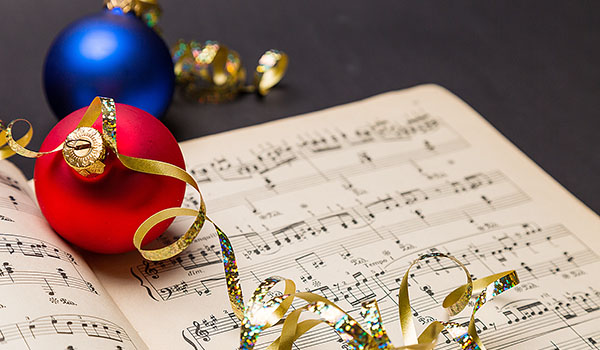The mysteries and surprises behind Christmas carols

Ah, December. Turn up the radio and hear those ring-ting-tingling Christmas Carols. By definition, a carol is a song of joy or mirth often pertaining to religious joy. Although mostly associated with Christmas, they originated with pagan festivities surrounding the winter solstice. Those same festivities brought us the Christmas tree and kissing under the mistletoe.
As early Christians spread their faith among the peoples of pagan lands, many practices of the winter solstice were blended with those of Christianity. In the dead of winter a celebration of rebirth of life was symbolized in the birth of Christ. The time of winter solstice, when the days grew longer again - the return of the light - became the hope of the world in the birth of Christ, the "Light of the World."
As Christianity spread, familiar carols with a pagan text were replaced with texts announcing the birth of Jesus and stories of His parents, Mary and Joseph. Many popular Christmas carols have their roots in 11th- to 18th-century England.
Probably the most well known story surrounding a Christmas carol is associated with "Silent Night." It was written in 1818 for a Christmas Eve service in St. Nicholas Church, Oberndorf, in Upper Austria. Father Joseph Mohr, an assistant priest, asked the organist, Franz Gruber, to set the "Silent Night" text for two voices, choir and guitar. It's believed this arrangement was asked for because the church organ was not in service. Legend has it that mice had eaten through the bellows of the organ therefore providing no wind for the organ pipes. It's also believed that the organ repairman who arrived at the church several days later found the score of "Silent Night" in the choir loft and it was he who initially began the spreading of "Silent Night" throughout Austria, perhaps on his journeys to tune and repair other pipe organs.
"The First Noel," also known as "The First Nowell," is believed to have originated in France during the 15th century. Noel is a French word meaning birthday. The song is thought to have been brought into England by the wandering troubadours sometime before 1823. Under the English form, "Nowell," the carol became a great favorite for Christmas Eve, especially in the west of England. As with most traditional songs, the lyrics have evolved over the years. The popular American version comes from "Carols Old and Carols New" by Rev. Charles Lewis Hutchins, published in 1916.
The song has been recorded by Bing Crosby, the Supremes and Elvis Presley, as well as Neil Diamond and Bob Dylan, both Jewish.
"Joy to the World" is an unusual Christmas hymn. It is based on a psalm and it celebrates Christ's Resurrection more than His birth, drawing its initial inspiration not from the Christmas narrative in Luke 2, but from Psalm 98. This hymn came to be as a result of collaboration of at least three people.
English hymn writer Isaac Watts wrote the lyric, first published in 1719. Portions of Handel's "Messiah" were used to make the tune popular in North America. Borrowing other's music was as popular back then as sampling is today. Lowell Mason, a musician with significant influence in his day, published his own arrangement of Handel's melodic fragments in "Occasional Psalms and Hymn Tunes" (1836) and named the tune "Antioch." While this is not the only tune to which Watts' text is sung, it is certainly the dominant one.
It is the most published Christmas hymn in North America, and has been recorded by Bing Crosby and Neil Diamond. Mariah Carey recorded a version that blended in the Three Dog Night song of the same name, written by Hoyt Axton. Somehow, it became a club hit.
"O Come All Ye Faithful" has Latin roots, first being known as "Adeste Fideles." Several authors have been credited with writing the carol, including St. Bonaventure in 13th century, King John IV of Portugal in the 17th century, and an order of monks. Its oldest manuscript dates back to 1751. The Latin text comes from the Roman Catholic tradition, found in the 18th-century manuscript in the College at Douai, located in northern France.
The invitation to "come, all ye faithful ... to Bethlehem" places the singer both among the shepherds who rushed to see the Christ child, and in the long procession of the "faithful" that have journeyed to Bethlehem in their hearts for over 2,000 years. Of particular note is the second stanza that draws heavily upon the Nicene Creed.
Some modern day carols include "We Three Kings," written by John Henry Hopkins Jr. in 1857, rector of Christ Episcopal Church in Williamsport, Pa., for a Christmas Pageant in New York City.
Katherine Kennicott Davis, a classical composer, wrote "The Little Drummer Boy," also known as "Carol of the Drum," in 1941, based upon a Czech family carol. The Trapp Family singers first recorded it a decade later. It inspired a 1976 Rankin/Bass Claymation special for television.
The carol has been recorded by such a diverse groups as Andy Williams, Marlene Dietrich, the Vince Guaraldi Trio (for the Soundtrack to "A Charlie Brown Christmas"), Jimi Hendrix, the Brady Bunch and Bing Crosby, rather infamously with David Bowie.
Special thanks to Alan Lukas, diocesan director of Music, MakingMusicFun.com, CBN.com, www.umcdiscipleship.org, Howard Culbertson at Southern Nazarene University for providing information.




